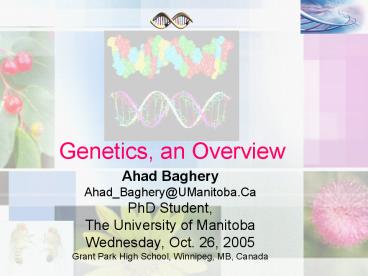Genetics, an Overview - PowerPoint PPT Presentation
1 / 25
Title:
Genetics, an Overview
Description:
The two members of a heredity factor pair segregate from each other in the formation of gametes. ... Only DNA changed the heredity of the living harmless ... – PowerPoint PPT presentation
Number of Views:522
Avg rating:5.0/5.0
Title: Genetics, an Overview
1
Genetics, an Overview
- Ahad Baghery
- Ahad_Baghery_at_UManitoba.Ca
- PhD Student,
- The University of Manitoba
- Wednesday, Oct. 26, 2005
- Grant Park High School, Winnipeg, MB, Canada
2
Outline
- Introduction
- Model organisms
- Cell division Mitosis, Meiosis
- Mendelian principles of genetics
- Key experiments
- DNA, RNA, Transcription, Translation
- PCR A revolution
- Genetic engineeringRecombinant DNA technology
- Applications of genetics
- Branches of Genetics
3
Introduction
A Paradox Genetics is Hard Because it is Simple.
- Genetics the scientific study of inheritance and
its underlying mechanisms. - Genetics The study of the structure and
function of genes and the transmission of genes
from parents to offspring.
4
Model organisms
- Corn
- Yeast
- Rapid Cycling Brassica
- Pea
- Fruit fly
- Arabidopsis
5
Cell division Mitosis, Meiosis
6
Mendelian principles of genetics
Gregor Mendel, 1822-1864
- Monohybrid cross Law of Segregation
- Dihybrid cross Law of Independence
7
Monohybrid cross
8
Monohybrid cross
3 Spherical1Wrinkled
9
Monohybrid cross
Mendels first law The Principle of
Segregation The two members of a heredity factor
pair segregate from each other in the formation
of gametes.
Now Two members alleles Hereditary factor
gene
10
Dihybrid cross
11
Dihybrid cross
Mendels second law The Principle of
independence During gamete formation, members of
one heredity factor pair segregate into gametes
independently from other heredity factor pairs.
Now Two members alleles Hereditary factor
gene
12
Key experiments
- Morgan 1866-1945
- Griffith 1881-1941
- Avery 1877-1955
- Watson Crick
13
Morgans experiment
Conclusion Genes are located on chromosomes.
14
Griffiths experiment
Conclusion Some principles should be
transferred from the dead harmful strain into
living harmless strain making transformation.
15
Averys experiment
harmful strain
Isolate and purify macromolecules
Proteins RNA DNA
Carbohydrates Lipids
Treat living harmless strain with the purified
chemicals
harmful strain
Only DNA changed the heredity of the living
harmless strain
Conclusion DNA is the principle of
transformation
16
Watson Crick
The double helix structure of DNA, the giant
molecule of life.
17
(No Transcript)
18
DNA, RNA, Transcription, Translation
- DNA replication the process by which new DNA
molecules (and thus new copies of genetic
information) are synthesized. - Transcription the templating process that
results in synthesis of a strand of RNA
containing a copy of specific genetic information
found in DNA. - Translation synthesis of a polypeptide whose
amino acid sequence is determined by the
nucleotide sequence of RNA.
19
DNA, RNA, Transcription, Translation
DNA replication
20
PCR A revolution
- Polymerase Chain Reaction
- A technique for replicating a specific piece of
DNA in-vitro , even in the presence of
excessnon-specific DNA. - Nobel Prize Kary Mullis 1993
- "DNA Xeroxing" in vitro (cell-free) DNA
"cloning"
21
Genetic engineeringRecombinant DNA technology
- select the desired gene (or genes) to be inserted
into the organism - cut two DNA molecules into fragments with special
(restriction) enzymes - splice the fragments together in the desired
combination - introduce the new DNA into a living cell for
replication
22
Genetic engineeringRecombinant DNA technology
23
Applications of genetics
- Medicine, hereditary diseases gene therapy
strategies against - cancer,
- Alzheimer's disease,
- Parkinson's disease,
- heart disease,
- diabetes,
- multiple sclerosis, and
- AIDS.
- Agriculture, Breeding for
- Disease resistance,
- Pest resistance,
- High production yield,
- High quality,
- Stress resistance, and
- Livestock and pets.
- Industry,
- Crime Scene Investigation,
- Paleontology, species evolution, etc.
24
Branches of Genetics
- Classical or Mendelian genetics
- Cytogenetics
- Molecular genetics
- Genetic engineering
- Population genetics
- Quantitative genetics
- Genomics study of large-scale genetic patterns
across the genome for (and in principle, all the
DNA in) a given species. - genetics of bacteria, viruses, insects, animals
and plants, as well as humans
25
The End
- Questions?































